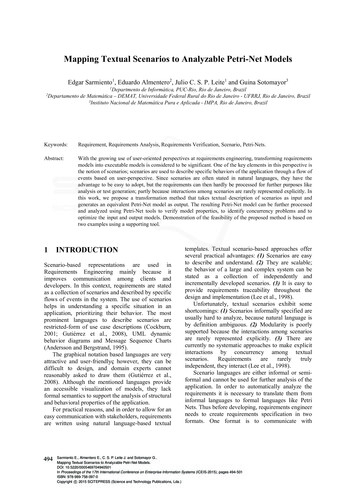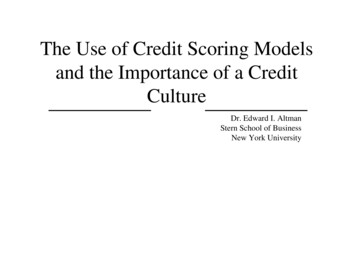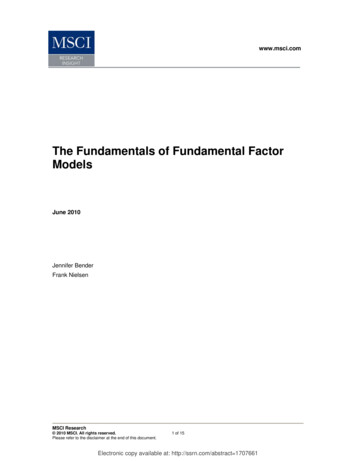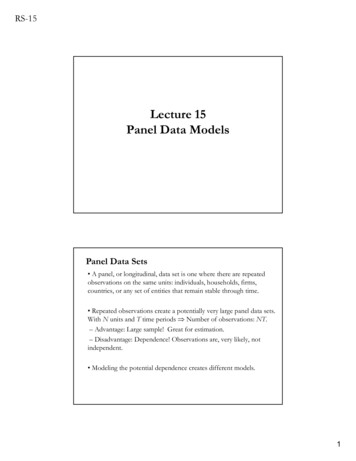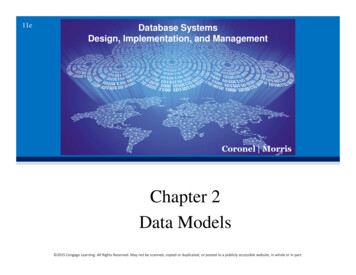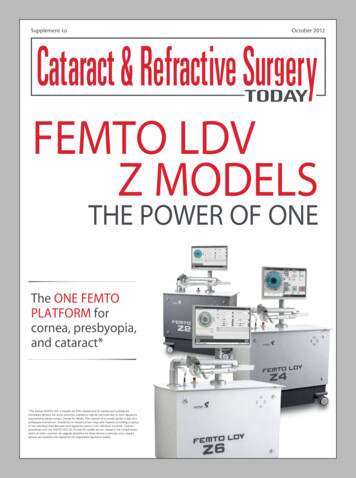
Transcription
Supplement to October 2012FEMTO LDVZ MODELSTHE POWER OF ONEThe ONE FEMTOPLATFORM forcornea, presbyopia,and cataract**The Ziemer FEMTO LDV Z Models are FDA cleared and CE marked and available forimmediate delivery. For some countries, availability may be restricted due to local regulatoryrequirements; please contact Ziemer for details. The creation of a corneal pocket is part of apresbyopia intervention. Availability of related corneal inlays and implants according to policyof the individual manufacturers and regulatory status in the individual countries. Cataractprocedures with the FEMTO LDV Z2, Z4 and Z6 models are not cleared in the United Statesand in all other countries. An upgrade possibility for these devices is planned once cataractoptions are available and cleared by the responsible regulatory bodies.
FEMTO LDV Z MODELSZIEMER IS THE FEMTO-TECHNOLOGYCOMPANY OF TODAY, TOMORROWAND THE FUTURETHE POWER OF ONECONTENTSIntroductionFEMTO LDV Z MODELS: An Exciting Journey into New Femtosecond Laser TechnologyBy Peter W. Rieck, MD, PhD. . . . . . . . . . . . . . . . . . . . . . . . . . . . . . . . . . . . . . . . . . . . . . . . . . . . . . . . . . . . . . . . . 3ArticlesThe Ultimate Femtosecond Laser TechnologyBy Minoru Tomita, MD, PhD. . . . . . . . . . . . . . . . . . . . . . . . . . . . . . . . . . . . . . . . . . . . . . . . . . . . . . . . . . . . . . . . 4Laser Technology of the FEMTO LDV Z MODELSBy Holger Lubatschowski, PhD. . . . . . . . . . . . . . . . . . . . . . . . . . . . . . . . . . . . . . . . . . . . . . . . . . . . . . . . . . . . . . 8A Breakthrough in Femtosecond Laser TechnologyBy Scott M. MacRae, MD. . . . . . . . . . . . . . . . . . . . . . . . . . . . . . . . . . . . . . . . . . . . . . . . . . . . . . . . . . . . . . . . . 10Further Developments for the FEMTO LDV Z MODELSBy Francois Majo, MD, PhD. . . . . . . . . . . . . . . . . . . . . . . . . . . . . . . . . . . . . . . . . . . . . . . . . . . . . . . . . . . . . . . 12The FEMTO LDV Z MODELS: Representing the Concept of Swiss PrecisionBy Richard Foulkes, MD. . . . . . . . . . . . . . . . . . . . . . . . . . . . . . . . . . . . . . . . . . . . . . . . . . . . . . . . . . . . . . . . . . 152 Supplement to Cataract & Refractive Surgery Today October 2012
FEMTO LDV Z MODELSFEMTO LDV Z MODELS: AnExciting Journey into NewFemtosecond Laser TechnologyOffering a plethora of tools for refractive and corneal surgery.By Peter W. Rieck, MD, P h DFemtosecond laserABCapplications inophthalmology haverapidly evolved over thepast several years. Thistechnology has been widelyused for flap creation inLASIK surgery for quitesome time; however, evensince the introduction ofthe femtosecond laser, ithas been a constant goal to Figure 1. The FEMTO LDV (A) Z2, (B) Z4, and (C) Z6.provide more applicationsthan just cutting a LASIK flap. Very recently, the Ziemer Lubatschowski, PhD, provides an overview of Ziemer’sGroup has taken a great step forward to achieve thisfemtosecond laser technology. He shows that, with thegoal. The company’s FEMTO LDV Z MODELS are anew FEMTO LDV Z MODELS, the spot size remains ultrapowerful platform for performing a wide range ofsmall and that these spots completely overlap. This isprocedures in ocular surgery. These new FEMTO LDV Z thanks to the laser’s architecture, its most precise focusMODELS, which includes the Z2, Z4, and Z6 femtosecondquality, the low energy range, and the highest repetitionlaser models (Figure 1), released at the end of Februaryrate among all femtosecond laser systems.2012, address the demand of ophthalmologists for theNext, Scott MacRae, MD, focuses on Z-LASIK usingmost versatile, highly efficient femtosecond platform.the new FEMTO LDV Z MODELS. Further applicationsWith its latest advancements, the FEMTO LDV Zlike presbyopia treatment with the Kamra inlay areMODELS extend the range of surgical modalities we cancovered by Minoru Tomita, MD, PhD. Then, lamellaroffer our patients today.keratoplasty techniques using the FEMTO LDV ZOne of the major innovations of the FEMTO LDV ZMODELS will be addressed by Francois Majo, MD. Lastly,MODELS is the addition of the z-axis. This means thatRichard Foulkes, MD, details his experience and resultsthe Z4 and Z6 models now can move the focused laserwith the FEMTO LDV Z6.beam not just in the x- and y-axis but also in the z-axis.My colleagues and I hope that you will find theseFor LASIK surgery, this translates into a new Z-LASIKarticles informative and also relevant for your dailymethod, named Z-LASIK Z, that enables the resection toclinical practice. nbe performed three-dimensionally. Thanks to this newPeter W. Rieck, MD, PhD, is a Professor ofsystem, each flap can be customized to accommodateOphthalmology and Head of the Eye Hospitalthe desired geometry.Berlin-Marzahn in Berlin. Professor Rieck statesThis supplement summarizes the new and excitingsurgical tools that are now available with the FEMTO LDV that he has no financial interest in the productsor companies mentioned. He may be reached atZ MODELS. In the following pages, five surgeons sharee-mail: p.rieck@augenklinik-berlin.de.their experiences with this advanced technology. HolgerOctober 2012 Supplement to Cataract & Refractive Surgery Today 3
FEMTO LDV Z MODELSThe Ultimate FemtosecondLaser TechnologyThe newest FEMTO LDV Z MODELS have expanded modules for vertical cuts,including one for intrastromal pocket creation.By Minoru Tomita, MD, P h DAt Shinagawa LASIK Center in Tokyo, we haveperformed more than 1 million LASIK cases sinceopening in 2004. We are committed to providingthe best quality treatments to our patients by using theworld’s leading refractive technologies. Therefore, westarted performing femto-LASIK with the FEMTO LDVfemtosecond laser (Ziemer Group) in 2009. In this time,we have come to realize that the FEMTO LDV is theideal technology for refractive surgeons who desire tocomplete their LASIK procedures with a high level ofsafety and patient satisfaction.The clinical outcomes, surgical quality, and usabilityof the first and second FEMTO LDV sytems were excellent, and we recently worked together with Ziemer tofurther improve the laser system in several areas, includingthe addition of multiple vertical cutting settings. Ziemerhas now developed these systems and released its newFEMTO LDV Z MODELS with remarkable features that fulfilled our expectations. Three models, the Z2, Z4, and Z6,are new to the market. We have started using theseFEMTO LDV Z MODELS for corneal surgery in our clinic.Below I report the clinical outcomes of LASIK using thesenew FEMTO LDV Z MODELS and also the outcomes frompost-LASIK Kamra corneal inlay (AcuFocus, Inc.) implantation performed with Ziemer pocket-creating technology.ADVANTAGES OF THE FEMTO LDV Z MODELSUpon review of our experiences with the FEMTO LDVZ MODELS compared with other femtosecond lasers,we found that this laser excels in LASIK flap creation.The FEMTO LDV Z MODELS offer surgeons and patientsmany advantages:High-speed, low-energy scanning system. The FEMTOLDV Z MODELS have a high-speed scanning systemthat generates low-energy laser pulses at the nanoJoule(nJ) level with high-pulse frequencies exceeding 5 MHz.According to an analysis of the effects of different energylevels on corneal stromal cells, greater inflammatory cellinfiltration was observed in the cornea when using laserswith higher energy levels.1 These higher energy levels alsotriggered increased cell death. Additionally, typicalcomplications caused by some femtosecond lasers, suchas vertical gas breakthrough, rainbow glare, transient lightsensitivity syndrome (TLS), opaque bubble layer (OBL)formation, and inflammation, were induced by higherpulse energy femtosecond lasers.2-5Tissue preservation. During flap creation with theFEMTO LDV Z MODELS, small and tightly overlappeddissection spots are produced, resulting in completeresection with no tissue bridges and a smooth stromalbed. It also produces significantly fewer gas bubbles andis free of edema. Besides tissue preservation, the handheldscanning device affords the surgeon a direct view of thecornea and ensures a highly precise cutting depth.Ergonomic design. Laser energy is deployed from ahandpiece that is attached to a maneuverable articulatedarm, meaning patients can be treated on the excimerlaser bed instead of relocating between the flap creationand ablation procedures. Using the FEMTO LDV ZMODELS, both surgeon and patient can stay in a singleposition. Therefore, the entire bilateral Z-LASIK procedurecan be completed within 6 minutes.Short procedure time. As the scanning system improvedthe speed of the operation, the cutting time using FEMTOLDV Z MODELS is now less than 15 seconds. Patients aremore comfortable and feel less stress during the procedure.NEW FEMTO LDV Z MODELS: VARIETY OFFUNCTIONSIn addition to the characteristics and capabilities ofthe current model, several functions were added tothe new FEMTO LDV Z4 and Z6. These FEMTO LDV ZMODELS have a variety of functions, including creationof intrastromal pockets for corneal inlays, keratoconustreatment with tunnel resection for intracorneal ringsegments, and corneal keratoplasty. The most outstandingfeature of the FEMTO LDV Z MODELS is their ability toresect three-dimensionally.4 Supplement to Cataract & Refractive Surgery Today October 2012
FEMTO LDV Z MODELSflap thickness was 1.0 3.9 µm. No intraoperativeor postoperative complications were observed inthe studied cohort. Weconcluded that the FEMTOLDV Z MODELS were morepredictable than any otherfemtosecond laser as well asthe microkeratome in termsof intended flap thickness.6CORNEAL INLAYSURGERY FORPRESBYOPIACORRECTIONAs the population ofmiddle-aged and olderadults grows, the demandfor presbyopia-correctingtreatments rapidly increases.One surgical solution thatis attracting attention isthe Kamra corneal inlay(AcuFocus, Inc.). ThisFigure 1. Options (A and B) for creating the flap edge available with the FEMTO LDV Z4 andintracorneal inlay is designedZ6 Models.to create a small apertureeffect to increase the depthThe FEMTO LDV Z MODELS enable users to changeof focus in the eye. To complete the procedure, a cornealflap creation details (Figure 1) such as flap thickness,inlay is implanted under a 200-μm LASIK flap or inside asidecut angle (30º to 150º), and shape (oval or circular)corneal pocket. The inlay controls light transmission, allowon the advanced settings screen. Even after applanatinging only central rays to reach the retina through a fixedthe cornea, the surgeon can change settings including1.6-mm aperture. This enables the eye to see near and interflap position and diameter and hinge position.mediate objects more clearly. We began working with theKamra inlay in 2009 and since then have performed moreSTUDY OUTCOMES WITH THE femto ldv Z4than 8,000 procedures.In a prospective, noncomparative study conducted atIn that time, I began to explore the possibility ofthe Shinagawa LASIK Center, 77 eyes (39 patients; meanpresbyopia correction using the inlay in ametropic andage, 33 8 years) underwent LASIK using the FEMTOprevious LASIK patients. We also evaluated the outLDV Z4 for flap creation and the Amaris excimer lasercomes of simultaneous LASIK (“SIM-LASIK”) and inlay(Schwind-eye-tech solutions) for myopic correction. The implantation in patients with refractive errors. Whatattempted flap thickness was 90 to 100 μm, and visualwe found is that combining the Kamra corneal inlayoutcomes (Figure 2) and flap thicknesses were evaluated with LASIK provides excellent visual outcomes and highat 1 day, 1 week, and 3 months after LASIK.patient satisfaction.7All eyes achieved distance UCVA of 20/20 or better,POST-LASIK PRESBYOPIA CORRECTIONand 90% of 20/16 or better at 3 months postoperatively.USING THE FEMTO LDV Z modelsSimilarly, at 3 months all eyes achieved distance BCVAWe recently began implanting the Kamra inlay in postof 20/20 or better and 96.7% of 20/16 or better. ForLASIK patients who returned to our clinic for presbyopiapostoperative manifest refraction spherical equivalent(MRSE) at 3 months, 86.7% of eyes achieved results within correction. The adjustable pocket software of the FEMTOLDV Z MODELS can be used to create an intrastromal 0.50 D and 100% within 1.00 D.pocket for insertion of the corneal inlay. During the proceAt our clinic, corneal and stromal pachymetry aremeasured just before and after flap creation with an ultra- dure, we make a smooth pocket at a depth of 200 to 250μm, underneath the old flap. The low-energy pulses of thesound pachymeter (Handy Pachymeter SP100; TomeyFEMTO LDV Z MODELS create significantly less inflammaCorporation). The mean ( SD) difference from intendedOctober 2012 Supplement to Cataract & Refractive Surgery Today 5
FEMTO LDV Z MODELSFigure 3. Anterior segment OCT. This Image shows that theprevious LASIK flap was made at about 100 µm and the newpocket at 200 µm.Figure 4 demonstrates the visual outcomes of thisstudy. Follow-up for 484 patients was available at 6 months.Mean distance UCVA had declined 1 line from 20/16 to20/20; 84% were 20/25 or better, and 74% were 20/20or better. Near UCVA improved 4 lines, from J8 to J2.Additionally, 82% achieved J3 or better. The 6-monthfollow-up also showed excellent patient satisfaction, with94% reporting satisfaction with their UCVA.Overall, I have been impressed with the results fromKamra inlay surgeries using the Ziemer FEMTO LDV ZMODELS. Like previously reported results for emmetropicpresbyopes, our patients experienced gains in near visualacuity while gaining or maintaining good distance UCVA.As a result, we have made the inlay our only choice forpresbyopia correction in patients without cataracts. Thissurgical technique is easy to perform, and patients arepleased with their visual outcomes. The inlay has provento be a good solution for both ametropic and postLASIK presbyopes.Figure 2. Visual and refractive outcomes of eyes thatunderwent Z-LASIK with the FEMTO LDV Z4.tion, and thus far no complications have been observed.Therefore, in our clinic, the FEMTO LDV Z4 is necessary forcreating an ideal pocket for post-LASIK Kamra surgery.We recently evaluated Kamra inlay implantation in 2,193patients who were treated with LASIK but returned toour clinic for presbyopia correction between November2010 and February 2012. This group of patients had amean preoperative spherical equivalent refraction of-0.11 D (range, 2.38 to -2.00 D). All patients had a LASIKflap, so we created the corneal pocket under their priorflap interface. The lamellar pocket was created with theFEMTO LDV Z MODELS adjustable pocket softwarein patients’ nondominant eyes at the depth of 100 μmbelow their LASIK flap (Figure 3). The new pocket wascreated at about 200 µm (Tomita Method). In somecases, the previous LASIK flap was lifted and a laserenhancement was performed to achieve a target refraction of plano. In all cases, the inlay was implanted at least1 month after LASIK.FORTHCOMING UPGRADESThe Z6 model is the latest version of the FEMTO LDVZ MODELS femtosecond laser. It keeps the full Z-LASIKcapabilities of the FEMTO LDV Z4 and adds capabilitiesfor both lamellar and penetrating keratoplasty. Moreover,the FEMTO LDV Z6 can be upgraded for femtosecondlaser-assisted cataract surgery, which will be available inthe near future.Thus, the new FEMTO LDV Z MODELS have improvedan already excellent laser by adding the ability to changecorneal flap shape, size, and thickness during the operation,while maintaining the characteristic of low tissue damagevia low-energy pulses. Accuracy and reproducibility offlap thickness also improved from the previous version, asthe new Z modules create precise flaps safely with goodpostoperative visual outcomes. The fast visual recoveryresulting from the FEMTO LDV Z MODELS’ gentletreatment enhances patient satisfaction. As refractivesurgeons, this is our top priority.We are working with Ziemer on the next upgrade tothe FEMTO LDV Z MODELS. The biggest feature is theaddition of an optical coherence tomography (OCT)module. Integrating this advanced multidimensionalscanning system will allow the surgeon to perform evensafer LASIK surgeries. This technology can be used to6 Supplement to Cataract & Refractive Surgery Today October 2012
FEMTO LDV Z MODELSexcellent characteristics and capabilities, such as thegentle treatment to the eye with low-energy pulses,and add significant improvements, including advancedsettings with which the user can change the flap positionand settings for the corneal conditions of each patient. Interms of flap creation, flap thicknesses created by the newFEMTO LDV Z MODELS are the most accurate and predictable when compared with other femtosecond lasers.Visual outcomes after Kamra implantation maydiffer depending on which femtosecond lasers surgeonsuse. We need to choose the right laser to create smooth200-μm pockets for the corneal inlay. As we review ourmany thousands of experiences creating pockets usingthe FEMTO LDV Z MODELS and other femtosecondlasers, clearly the FEMTO LDV Z MODELS is one of thebest femtosecond lasers for cutting into the deep partsof the corneal stroma. With further developments suchas OCT guidance and/or femto-cataract capabilities inthe near future, I believe the FEMTO LDV Z MODELSfemtosecond lasers will become an indispensable toolfor the ophthalmic surgeon desiring the safest and mostefficient surgeries. nFigure 4. Visual acuity of implanted eyes after post-LASIKKamra corneal inlay surgery.ensure enough distance between the Bowman layer andthe resection interface, thereby avoiding buttonholes whensub-Bowman LASIK is performed. Furthermore, in cases ofICRS implantation and/or corneal pocket creation for postLASIK patients, it is crucial to keep a safe distance from thestromal surface or endothelial layer to the ring tunnel orpocket layer. OCT is one of the most important functionsfor improving the safety of future corneal surgeries.conclusionThe results of our studies show that the new FEMTOLDV Z MODELS maintains the previous model’sMinoru Tomita, MD, PhD, is the ExecutiveDirector of the Shinagawa LASIK Center, Tokyo,Japan. Dr. Tomita states that he is a consultant toZiemer Group AG and AcuFocus, Inc. He may bereached at e-mail: tomita@shinagawa-lasik.com.1. de Medeiros FW, Kaur H, Agrawal V, et al. Effect of femtosecond laser energy level on corneal stromal cell deathand inflammation. J Refract Surg. 2009;25:869-874.2. Tomita M, Chiba A, Matsuda J, Nawa Y. Evaluation of LASIK treatment with the FEMTO LDV in patients withcorneal opacity. J Refract Surg. 2012;28:25-30.3. Bamba S, Rocha KM, Ramos-Esteban JC, Krueger RR. Incidence of rainbow glare after laser in situ keratomileusisflap creation with a 60 kHz femtosecond laser. J Cataract Refract Surg. 2009;35:1082-1086.4. Stonecipher KG, Dishler JG, Ignacio TS, Binder PS. Transient light sensitivity after femtosecond laser flap creation:clinical findings and management. J Cataract Refract Surg. 2006; 32:91-94.5. Mrochen M, Wullner C, Krause J, et al. Technical aspects of the WaveLight FS200 femtosecond laser. J RefractSurg. 2010;26:S833-840.6. Ahn H, Kim JK, Kim CK, et al. Comparison of laser in situ keratomileusis flaps created by 3 femtosecond lasers anda microkeratome. J Cataract Refract Surg. 2011;37:349-357.7. Tomita M, Kanamori T, Waring GO IV, et al. Simultaneous corneal inlay implantation and laser in situ keratomileusis for presbyopia in patients with hyperopia, myopia, or emmetropia: six-month results. J Cataract Refract Surg.2012;38:495-506.October 2012 Supplement to Cataract & Refractive Surgery Today 7
FEMTO LDV Z MODELSLaser Technology of th
Next, Scott MacRae, MD, focuses on Z-LASIK using the new FEMTO LDV Z MODELS. Further applications like presbyopia treatment with the Kamra inlay are covered by Minoru Tomita, MD, PhD. Then, lamellar keratoplasty techniques using the FEMTO LDV Z MODELS will be addressed by Francois Majo, MD. Lastly,
